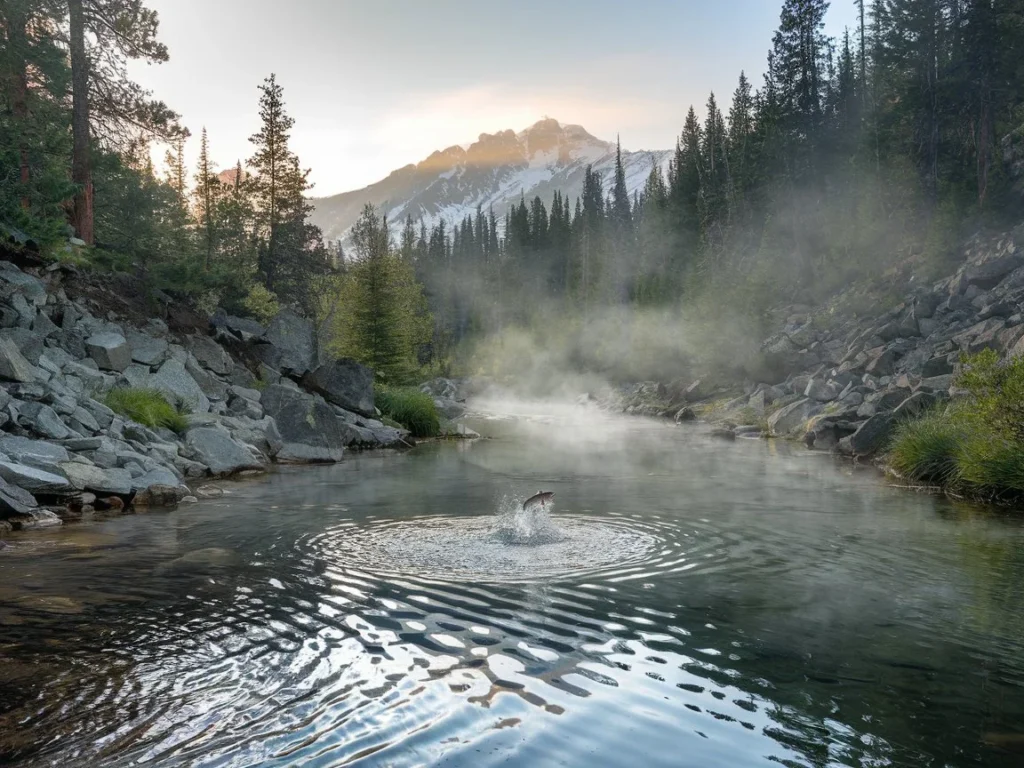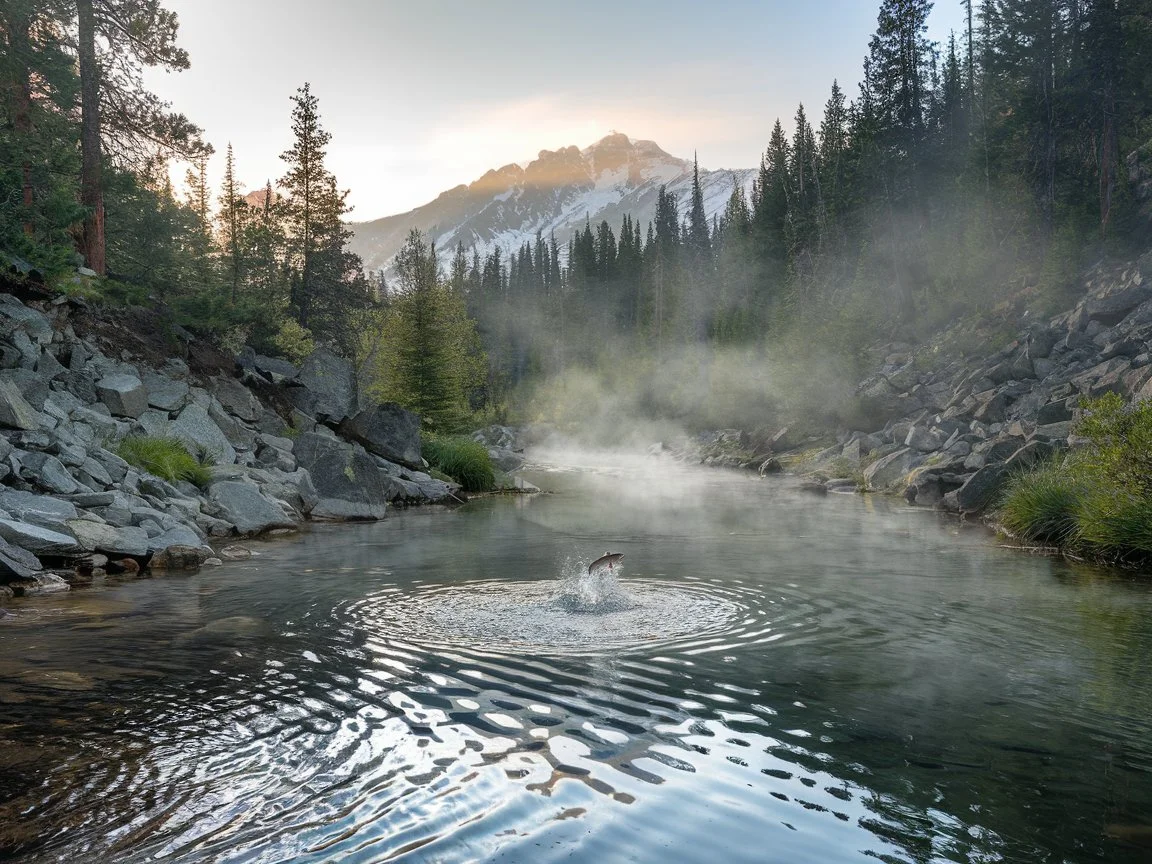
Introduction
Fishing in mountain streams and lakes is more than just a pastime—it’s a serene and rewarding way to connect with nature. The crisp mountain air, the sound of rushing water, and the thrill of a bite create an experience that’s both relaxing and exhilarating. Whether you’re casting a line into a crystal-clear stream or sitting by a tranquil alpine lake, mountain fishing offers a unique escape from the hustle and bustle of everyday life.
Mountain regions are home to a variety of fishing styles, including fly fishing, spin fishing, and bait fishing. Each method has its own charm and challenges, catering to different preferences and skill levels. Fly fishing, for example, is a delicate art that requires precision and patience, while spin fishing offers a more dynamic and accessible approach. Bait fishing, on the other hand, is perfect for those who enjoy a slower, more traditional experience.
This guide will take you through everything you need to know to make the most of your mountain fishing adventure. From the best destinations and types of fish to essential gear, techniques, and seasonal tips, we’ve got you covered. So grab your rod, pack your gear, and get ready to explore the pristine waters of the mountains.
1. Best Mountain Destinations for Fishing
Mountain regions are home to some of the most picturesque and productive fishing spots in the world. Here are three top destinations to consider for your next fishing trip:
- Location 1: Yellowstone National Park, Wyoming
- Description: Known as the birthplace of American fly fishing, Yellowstone offers a diverse range of fishing opportunities. From the famous Yellowstone River to the park’s countless streams and lakes, there’s something for every angler.
- Types of Fish: Rainbow trout, cutthroat trout, brown trout, and brook trout.
- Accessibility: Many fishing spots are easily accessible by car or short hikes, making it a great destination for families and beginners.
- Location 2: Great Smoky Mountains National Park, Tennessee/North Carolina
- Description: The Smokies are home to over 2,000 miles of streams, offering some of the best trout fishing in the eastern United States. The park’s lush forests and cascading waterfalls create a stunning backdrop for your fishing adventure.
- Types of Fish: Rainbow trout, brown trout, and brook trout.
- Accessibility: While some streams are easily accessible, others require moderate hikes, making it a great destination for those who enjoy a bit of adventure.
- Location 3: Rocky Mountain National Park, Colorado
- Description: With over 50 lakes and numerous streams, Rocky Mountain National Park is a paradise for anglers. The park’s high-altitude waters are teeming with trout, and the rugged mountain scenery is simply breathtaking.
- Types of Fish: Rainbow trout, brook trout, and greenback cutthroat trout.
- Accessibility: Many fishing spots are accessible by car, but some of the best locations require hiking, offering a more secluded experience.
2. Types of Fish Found in Mountain Waters
Mountain streams and lakes are home to a variety of fish species, each with its own unique characteristics and challenges. Here’s a closer look at the most common types of fish you’ll encounter:
- Trout: Trout are the most popular fish in mountain waters, and for good reason. They’re abundant, beautiful, and fun to catch.
- Rainbow Trout: Known for their vibrant colors and acrobatic fights, rainbow trout are a favorite among anglers.
- Brook Trout: These native fish thrive in cold, clear streams and are easily identified by their colorful markings.
- Brown Trout: Brown trout are known for their wariness and can be a challenging catch, making them a favorite among experienced anglers.
- Cutthroat Trout: Named for the distinctive red slash under their jaw, cutthroat trout are a prized catch in western mountain streams.
- Bass & Pike: While less common in high-altitude streams, bass and pike can be found in larger mountain lakes.
- Largemouth Bass: These aggressive fish are a blast to catch and are often found in warmer, weedy areas of lakes.
- Northern Pike: Known for their sharp teeth and powerful strikes, pike are a thrilling catch for those who enjoy a challenge.
- Other Species: Depending on the region and elevation, you may also encounter unique fish like grayling, char, and whitefish. These species add variety to your fishing experience and are often found in remote, high-altitude waters.
3. Essential Fishing Gear for Mountain Streams and Lakes
Having the right gear is crucial for a successful and enjoyable fishing trip. Here’s a breakdown of the essentials:
- Fishing Rods & Reels:
- Fly Fishing: A 9-foot, 5-weight fly rod is a versatile choice for most mountain streams. Pair it with a matching reel and weight-forward floating line.
- Spin Fishing: A lightweight spinning rod (6-7 feet) with a smooth reel is ideal for casting lures in mountain waters.
- Bait Fishing: A medium-action spinning or baitcasting rod is perfect for bait fishing in lakes and larger streams.
- Bait & Lures:
- Fly Fishing: Dry flies, nymphs, and streamers are the most effective for mountain trout. Popular patterns include the Adams, Elk Hair Caddis, and Woolly Bugger.
- Spin Fishing: Small spinners, spoons, and soft plastics are great for trout and bass. Try using a Mepps Aglia or Panther Martin spinner.
- Bait Fishing: Natural baits like worms, salmon eggs, and PowerBait are highly effective for trout.
- Additional Gear:
- Waders: Chest waders with felt or rubber soles are essential for navigating slippery streams.
- Tackle Box: Keep your lures, flies, and tools organized in a compact tackle box.
- Net: A lightweight, collapsible net is handy for landing fish.
- Polarized Sunglasses: These reduce glare and help you spot fish in the water.
4. Best Fishing Techniques for Mountain Waters
Different fishing techniques work best in different conditions. Here’s a guide to help you choose the right approach:
- Fly Fishing:
- Casting Techniques: Master the basic overhead cast and roll cast for tight spaces. Practice your accuracy to place flies gently on the water.
- Best Flies: Match your flies to the local hatch. Dry flies like the Parachute Adams work well in summer, while nymphs like the Pheasant Tail are effective year-round.
- Spin Fishing:
- Using Lures: Cast upstream and retrieve your lure at varying speeds to mimic natural prey. Experiment with different colors and sizes to see what the fish are biting.
- Light Tackle: Use light line (4-6 lb test) for a more natural presentation and better sensitivity.
- Bait Fishing:
- Natural Baits: Use worms, salmon eggs, or PowerBait for trout. Rig them on a small hook with a split shot for weight.
- Rigging: Try a Carolina rig for lakes or a simple bobber rig for streams.
5. Seasonal Fishing Tips & Regulations
Fishing success often depends on the season and local conditions. Here’s what you need to know:
- Spring & Summer:
- Best Times: Fish are most active during early morning and late evening. Look for hatches of insects like mayflies and caddisflies.
- Strategies: Focus on shallow waters near shorelines and inlets where fish feed.
- Fall & Winter:
- Cold-Water Strategies: Fish move to deeper waters as temperatures drop. Use sinking lines or weighted flies to reach them.
- Ice Fishing: In winter, try ice fishing on frozen lakes. Use small jigs or live bait to catch trout and panfish.
- Understanding Local Fishing Laws:
- Catch-and-Release: Many mountain waters have catch-and-release rules to protect fish populations. Use barbless hooks and handle fish gently.
- Permits: Always check local regulations and obtain the necessary fishing permits.
- Conservation: Practice Leave No Trace principles and respect wildlife habitats.
6. Planning the Perfect Fishing in mountain streams and lakes Getway
A well-planned fishing trip ensures a smooth and enjoyable experience. Here’s how to make it happen:
- Choosing a Cabin: Look for a cabin near prime fishing spots. Many mountain lodges offer easy access to streams and lakes, as well as amenities like fireplaces and hot tubs.
- Packing Essentials: Bring layers of clothing, rain gear, and sturdy footwear. Don’t forget your fishing gear, food, and a first-aid kit.
- Combining Activities: Pair fishing with hiking, wildlife watching, or simply relaxing by the fire. A mountain getaway is the perfect opportunity to unwind and recharge.
Conclusion
Fishing in mountain streams and lakes is a timeless activity that offers both relaxation and excitement. Whether you’re casting a fly on a sparkling stream or trolling for trout in an alpine lake, the experience is sure to leave you with lasting memories. By choosing the right destination, gear, and techniques, you can make the most of your mountain fishing adventure. So pack your gear, explore new waters, and embrace the joys of fishing in the mountains. Remember, the fish are waiting—will you answer the call?
You can Explor more in our Guide: Top Fishing Spots and Tips for a Relaxing Mountain Cabin Retreat

